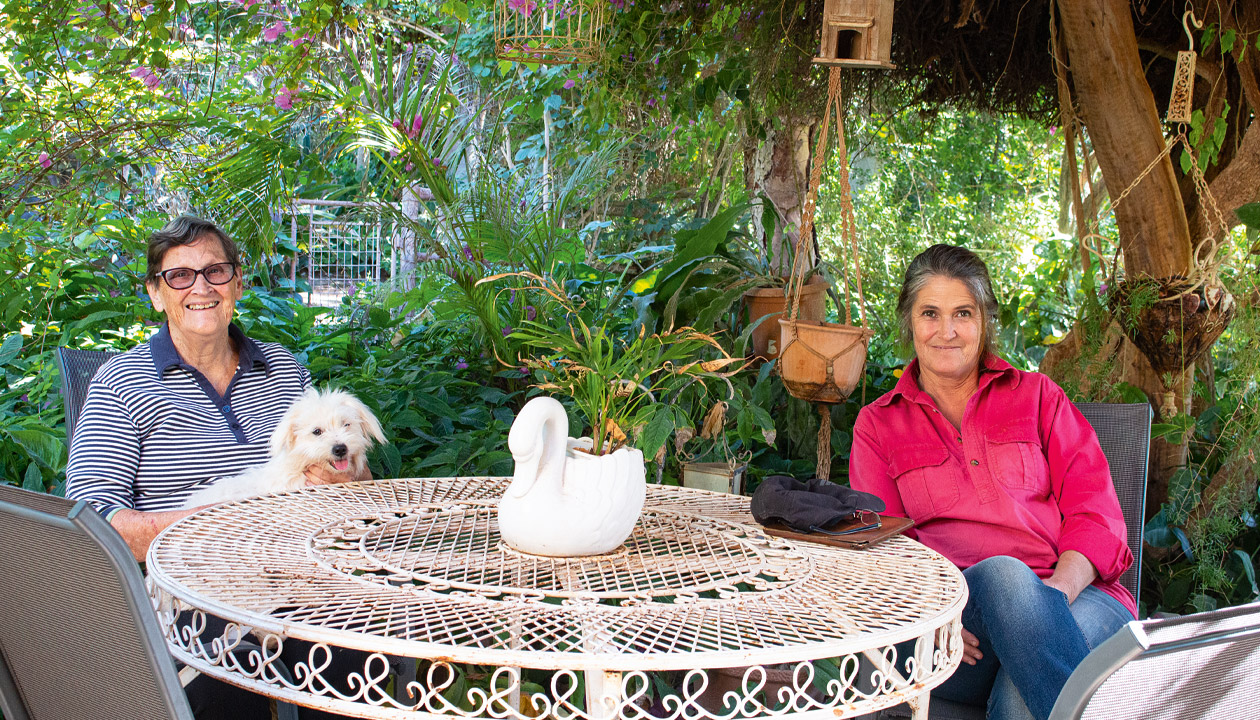Over two generations, the Corbett family has created a diverse garden retreat at Chumvale station in north-western Queensland.
Story + Photos Vicki Wilson
It’s a short, scenic 15km drive to Chumvale, north-west of Cloncurry, Qld, with yellow turpentine wattle, kangaroos and a horse paddock decorating the property’s red-dirt roadside. As you near the cattle station complex by Butchers Creek, the towering trees and blankets of green hint that an oasis awaits, but give hardly a clue as to the colour explosions and interesting features that lay within.
The first house you come to belongs to Margaret Corbett, or Grandma, who moved to the long-held family station from Brisbane with her husband Alf and young family in 1965. “Our house had two rooms back then and there was only one tree – an acacia that still stands – and carpets of khaki burr,” Margaret says. “I pulled the weeds by hand and, since I love trees, I kept putting them in.”
These days Margaret’s yard boasts two 50-year-old poincianas, well-established bottlebrush that the parrots love, java plum, a big gum tree she collected as a sapling out of the river, frangipani and bauhinia. A long, wide path flanked by lawn leads from the front gate past a scarlet ixora to the patio and kitchen. Shaped bougainvillea are scattered throughout and more climb the trees, adding bursts of orange, pink and white to the shady surrounds all year. “My garden wouldn’t be anything without my bougainvillea,” Margaret says.
When the nearby Mary Kathleen uranium mine closed in the early 1980s, the Corbetts bought two houses, which they relocated to Chumvale. One was added as an extension to the main house, while the other was placed next door for men’s quarters, before eventually being modified to become home for son David and his wife Tracey, who moved from another family property in 1998. Alf passed away in 2002.
Behind Margaret’s house, which she now shares with her two Maltese dogs, the old Mary Kathleen Post Office is used as a guest cottage. There’s a meat house, coldroom and fernery, featuring potted plants and bush furniture made by a man who once lived at the station. Stone paths lead you past beds of flowers, ornamental grasses and shrubs, while desert roses grow best in too many pots to count. Further back, a windmill peeks above the buildings and foliage. A row of mock oranges borders the immense “chook palace” that hosts 25 free-range chickens and leads to David’s gigantic fruit and veggie patch beyond.
Here you’ll find tomatoes, butter beans, green beans, squash, zucchini, beetroot, radishes, silverbeet, Asian greens, cabbages, broccoli, lettuces, pumpkins and melons. You’ll also find David, when he’s not out working or enjoying cooking with Tracey, and at times cockatoos and bowerbirds feasting within the uncovered section.
An almost secret gate through the greenery opens to reveal more pleasant surprises next door. Tracey, who hails from New Zealand, where she grew up surrounded by flowers, has not been deterred by Cloncurry’s heat, termites or bore water. Through trial and error over the years and from a base of only three original trees, she has created a down-to-earth yet magnificent garden, sourcing many plants deliberately online and from all over the country.
A garlic creeper adds a lavender splash high up among the gums while beds of alstroemeria, nasturtiums, gazanias, ferns, hippeastrums and crinums project happiness from around the bases of shrubs and fruiting trees such as custard apples, white mulberries, lemons, chocolate sapotes, soursops, carambolas and olives.
This story excerpt is from Issue #127
Outback Magazine: Oct/Nov 2019










